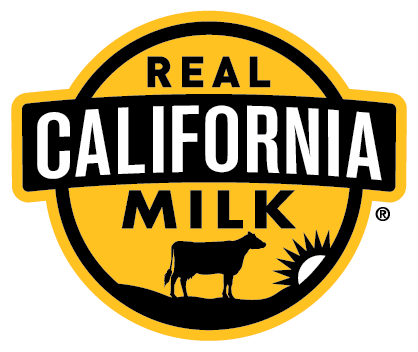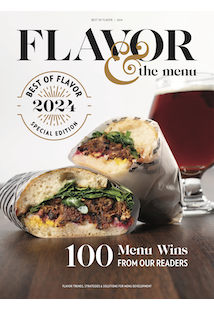
SPONSORED EDITORIAL
Making Sustainable Attainable
Planet-smart production strategies make California dairy a sustainable foodservice partner
SPONSORED EDITORIAL
Making Sustainable Attainable
Planet-smart production strategies make California dairy a sustainable foodservice partner
By Flavor & The Menu
July 26, 2024
By Flavor & The Menu
July 26, 2024
For California dairy families, sustainability is both a generations-long legacy and a commitment to the future. It means producing high-quality food that is good for people and the planet using ever-evolving agricultural processes.
While recent consumer research finds a gap between aspirations and actions when it comes to making food and beverage choices based on sustainability (International Sustainable Food Barometer, Sodexo, Harris Interactive 2024; 2023 Food & Health Survey, International Food Information Council 2024), the real impacts of climate change become more apparent every year. Rising food costs may be the most impactful driver around restaurant dining decisions today, but younger generations with a greater awareness and concern about behaviors that affect the environment will continue to compel innovation and reward change.
Savvy foodservice industry leaders recognize the sustainability imperative and are taking a variety of steps to respond. Among these is seeking out partners with a similar commitment. Operators can take pride in menuing California dairy products. The state is the nation’s largest dairy producer—and the leader in sustainable production practices. The carbon footprint of a glass of California milk has been reduced by more than 45 percent over the last 50 years and is among the smallest footprints for milk in the world.
“Sourcing sustainable, locally produced ingredients is very important to me and my patrons; it is at the core of what we do at the restaurants,” says Chef Lars Smith, a California Milk Advisory Board Ambassador and co-owner of State of Mind Restaurant Group. “It’s the right thing to do for the planet. I purchase California dairy cheese, butter and liquid dairy because of the industry’s commitment to sustainable production methods, in addition to California dairy delivering quality ingredients I can count on.”
California dairy farmers apply a multi-faceted approach to meet ambitious goals in various areas, from reducing greenhouse gas (GHG) emissions to conserving water usage—and much more. California dairies are working to reduce methane outputs by 40 percent from 2013 levels by 2030. Here are several planet-smart “tools” that are making a difference in the industry, with positive implications for foodservice operators and their guests.

Cow Care: Dietary Changes
Just as menu developers rely on the expertise of nutritionists to create better-for-you dishes, dairy farmers also use nutritionists to ensure cows are eating the healthiest foods for their own needs, as well as for the quality of the milk they produce. Today, dairy nutritionists are also reevaluating the components of conventional cow feed and making some changes that reduce the amount of enteric methane cows produce as a natural byproduct of the digestive process. A recently approved feed ingredient, 3-NOP, is anticipated to help reduce enteric methane emissions from cows by up to 30 percent. Several other feed ingredients, such as fatty acids, oregano, seaweed and tannins are also being explored.
Many California dairies use a “total mixed ration” (TMR), which is a blend of different feedstuffs necessary for optimal cow health and nutrition. It can include alfalfa hay, corn, wheat and other grass-based plants. California-developed TMRs feature a high percentage of byproducts from a diverse group of other California crops. These may include almond hulls, citrus and tomato pulp, culled carrots and other similar products that are not desirable for human consumption, but make nutritious feed for cows. More than 40 percent of feed ingredients used on California dairies are agricultural byproducts, keeping 15 thousand tons of waste out of landfills every day.
This type of “upcycling” can inspire foodservice operators to create a wholly unique “board” option that tells a compelling sustainability story. A Sustainable Grazing Board can feature various California cheeses and such California-centric accompaniments as candied dried oranges, sliced baguettes, raw almonds, fresh carrots and apples. Click here for suggestions.
Cow Care: Breeding/Genetics
Did you know that the level of methane produced by cows is an inherited trait? Breeding low-methane-producing cows is one of the ways California dairies are shaping future herds to be more climate friendly.
Cow Care: Improved Animal Health
The highest priority for California dairy farmers is the health, comfort and well-being of the animals in their care. This includes providing quality nutrition, comfortable housing, professional veterinary care and routine employee training. Today, more than 99 percent of the U.S. milk supply comes from farms participating in the National Dairy Farmers Assuring Responsible Management (FARM) third-party evaluation program; California was the first state to adopt the FARM program in 2010. Through FARM and other third-party animal welfare evaluation programs like it, dairy farmers, cooperatives, processors and industry partners work together to demonstrate and to continually advance the highest standards for animal care and comfort.
Smart Management of Natural Resources
California dairy farmers focus on recycling, reusing and refurbishing the natural resources on their property with an eye on preserving and extending existing resources and limiting the need for additional resources in the future. Strategies include carbon sequestration, enhanced carbon capture methods within grazing systems through improved pasture management and tree planting. Not only can these strategies mitigate methane emissions, they can protect farms against extreme weather conditions.
Farmers and processors in California’s dairy industry also are doing more in generating renewable energy, including solar and wind power, to offset emissions. More than 180 dairy farms are producing enough solar energy every year to power more than 32,000 homes. And through manure management, California dairy farms are applying new ways of handling and treating manure, including use of dairy digesters, which capture methane emissions from manure to create renewable energy.
California leads the nation in the development of dairy digesters, helping the transportation industry move from horsepower to “cowpower.” More than 129 dairy farms in California currently have digesters in operation. Another 100+ digester projects are in the works. The renewable natural gas and electricity produced by dairy digesters fuels thousands of transit buses and electric vehicles. In total, California dairy farms power more than 17,000 vehicles daily.
The water footprint of a glass of California milk also has been shrinking—more than 88 percent over 50 years. Water recycling is a common practice, with a single drop of water used up to four times on a dairy farm: cooling milk tanks, washing milking facilities and equipment, washing the cows and flushing manure from barn floors. This nutrient-rich water is captured for further use to irrigate crops.
California is home to more species of plants and animals than any other state in the nation. The state’s dairy farms and their forage fields play an important role in protecting and preserving that biodiversity. For example, by partnering with conservationists, dairy farmers are helping protect and repopulate the threatened tricolored blackbird species. Allowing these birds to safely nest in forage fields—often delaying or forgoing harvest—has led to greater reproductive success in recent years, which is likely a significant driver of increased population trends.
As previously mentioned, upcycling of foods into cow feed is one example of circular bioeconomies in sustainable farming. Food and beverage manufacturers are getting into the act here, as well. “The biggest realization is that waste isn’t waste,” says Emily Darchuk, Founder of Wheyward Spirit, on the company’s website.
It takes roughly 10 pounds of milk to produce one pound of cheese, leaving behind nine pounds of high-quality whey, the liquid co-product. Innovative companies are turning this into value-added products. Wheyward Spirit, for example, distills this “liquid gold” into two products—Wheyward Spirit and Wheyward Wheyskey—upcycling whey to a higher use. The company partners with dairies and cheesemakers to establish this circular approach, reducing the strain of food waste on the environment and lowering the impact of spirit production with lower carbon and water footprints.
Reducing Food Loss and Waste
Food loss and waste is a global problem, and foodservice operations have a role to play in minimizing their contributions to the problem. According to the National Restaurant Association, pre-consumer food waste is generated back-of-house, when kitchen staff over-orders supplies, over-produces the amounts needed, trims food poorly or lets it spoil in storage. An operation can end up discarding 4% to 10% of the food it purchases! When restaurants address waste and consequentially require less food to be produced, it can lead to greater efficiencies all around, as well as reduced methane emissions.
When it comes to dairy on the menu, are there certain products that you use only for select menu items, unable to use up a minimum order before it spoils? Chefs are encouraged to leverage the inherent versatility of different dairy products, being more mindful about using them across a greater variety of dishes, resulting in reduced (or zero) food waste, as well as cost savings to the bottom line.


LEADING & SUCCEEDING
“Real California Milk is proud to be the 2024 Flavor Experience Sustainability Partner,” says Katie Carmeron, foodservice business development, California Milk Advisory Board, of the mid-August 2024 event in San Diego. It’s an opportunity perfectly aligned with the industry’s commitment. “Not only do California dairy ingredients offer today’s chefs and menu developers versatility and flavor for innovation and inspiration, they are a perfect fit for foodservice operators interested in sustainability. Operators can be proud to menu California dairy.”
Click here to explore foodservice trends and resources from California Dairy. Learn more about the industry’s progress toward its sustainability goals by downloading California Dairy’s Sustainability Journey 2023.







